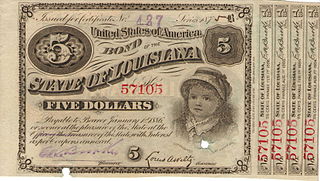Related Research Articles

In finance, a bond is an instrument of indebtedness of the bond issuer to the holders. The most common types of bonds include municipal bonds and corporate bonds. Bonds can be in mutual funds or can be in private investing where a person would give a loan to a company or the government.

A government bond or sovereign bond is an instrument of indebtedness issued by a national government to support government spending. It generally includes a commitment to pay periodic interest, called coupon payments, and to repay the face value on the maturity date. For example, a bondholder invests $20,000 into a 10-year government bond with a 10% annual coupon; the government would pay the bondholder 10% of the $20,000 each year. At the maturity date the government would give back the original $20,000.

A municipal bond, commonly known as a muni, is a bond issued by state or local governments, or entities they create such as authorities and special districts. In the United States, interest income received by holders of municipal bonds is often, but not always, exempt from federal and state income taxation. Typically, only investors in the highest tax brackets benefit from buying tax-exempt municipal bonds instead of taxable bonds. Taxable equivalent yield calculations are required to make fair comparisons between the two categories.

The Federal Old-Age and Survivors Insurance Trust Fund and Federal Disability Insurance Trust Fund are trust funds that provide for payment of Social Security benefits administered by the United States Social Security Administration.

A bearer bond is a bond or debt security issued by a business entity such as a corporation or a government. As a bearer instrument, it differs from the more common types of investment securities in that it is unregistered—no records are kept of the owner, or the transactions involving ownership. Whoever physically holds the paper on which the bond is issued is the presumptive owner of the instrument. This is useful for investors who wish to retain anonymity.

War bonds are debt securities issued by a government to finance military operations and other expenditure in times of war. They are also a means to control inflation by removing money from circulation from a stimulated wartime economy. War bonds are either retail bonds marketed directly to the public or wholesale bonds traded on a stock market. Exhortations to buy war bonds are often accompanied by appeals to patriotism and conscience. Retail war bonds, like other retail bonds, tend to have a yield which is below that offered by the market and are often made available in a wide range of denominations to make them affordable for all citizens.
The Low-Income Housing Tax Credit is a dollar-for-dollar tax credit in the United States for affordable housing investments. It was created under the Tax Reform Act of 1986 (TRA86) and gives incentives for the utilization of private equity in the development of affordable housing aimed at low-income Americans. LIHTC accounts for the majority of all affordable rental housing created in the United States today. As the maximum rent that can be charged is based upon the Area Median Income ("AMI"), LIHTC housing remains unaffordable to many low-income renters. The credits are also commonly called Section 42 credits in reference to the applicable section of the Internal Revenue Code. The tax credits are more attractive than tax deductions as the credits provide a dollar-for-dollar reduction in a taxpayer's federal income tax, whereas a tax deduction only provides a reduction in taxable income. The "passive loss rules" and similar tax changes made by TRA86 greatly reduced the value of tax credits and deductions to individual taxpayers. Less than 10% of current credit expenditures are claimed by individual investors.

United States Treasury securities are government debt instruments issued by the United States Department of the Treasury to finance government spending as an alternative to taxation. Treasury securities are often referred to simply as Treasurys. Since 2012, U.S. government debt has been managed by the Bureau of the Fiscal Service, succeeding the Bureau of the Public Debt.
A sinking fund is a fund established by an economic entity by setting aside revenue over a period of time to fund a future capital expense, or repayment of a long-term debt.

A mortgage-backed security (MBS) is a type of asset-backed security which is secured by a mortgage or collection of mortgages. The mortgages are aggregated and sold to a group of individuals that securitizes, or packages, the loans together into a security that investors can buy. Bonds securitizing mortgages are usually treated as a separate class, termed residential; another class is commercial, depending on whether the underlying asset is mortgages owned by borrowers or assets for commercial purposes ranging from office space to multi-dwelling buildings.

A corporate bond is a bond issued by a corporation in order to raise financing for a variety of reasons such as to ongoing operations, M&A, or to expand business. The term is usually applied to longer-term debt instruments, with maturity of at least one year. Corporate debt instruments with maturity shorter than one year are referred to as commercial paper.

The Federal Home Loan Banks are 11 U.S. government-sponsored banks that provide liquidity to the members of financial institutions to support housing finance and community investment.

The Argentine debt restructuring is a process of debt restructuring by Argentina that began on January 14, 2005, and allowed it to resume payment on 76% of the US$82 billion in sovereign bonds that defaulted in 2001 at the depth of the worst economic crisis in the nation's history. A second debt restructuring in 2010 brought the percentage of bonds under some form of repayment to 93%, though ongoing disputes with holdouts remained. Bondholders who participated in the restructuring settled for repayments of around 30% of face value and deferred payment terms, and began to be paid punctually; the value of their nearly worthless bonds also began to rise. The remaining 7% of bondholders were later repaid in full, after centre-right and US-aligned leader Mauricio Macri came to power in 2015.
A revenue bond is a special type of municipal bond distinguished by its guarantee of repayment solely from revenues generated by a specified revenue-generating entity associated with the purpose of the bonds, rather than from a tax. Unlike general obligation bonds, only the revenues specified in the legal contract between the bond holder and bond issuer are required to be used for repayment of the principal and interest of the bonds; other revenues and the general credit of the issuing agency are not so encumbered. Because the pledge of security is not as great as that of general obligation bonds, revenue bonds may carry a slightly higher interest rate than G.O. bonds; however, they are usually considered the second-most secure type of municipal bonds.

The Bureau of the Public Debt was an agency within the Fiscal Service of the United States Department of the Treasury. United States Secretary of the Treasury Timothy Geithner directed the Bureau be combined with the Financial Management Service into the single Bureau of the Fiscal Service in 2012.
A bond fund or debt fund is a fund that invests in bonds, or other debt securities. Bond funds can be contrasted with stock funds and money funds. Bond funds typically pay periodic dividends that include interest payments on the fund's underlying securities plus periodic realized capital appreciation. Bond funds typically pay higher dividends than CDs and money market accounts. Most bond funds pay out dividends more frequently than individual bonds.
Bond insurance, also known as "financial guaranty insurance", is a type of insurance whereby an insurance company guarantees scheduled payments of interest and principal on a bond or other security in the event of a payment default by the issuer of the bond or security. It is a form of "credit enhancement" that generally results in the rating of the insured security being the higher of (i) the claims-paying rating of the insurer or (ii) the rating the bond would have without insurance.

United States savings bonds are debt securities issued by the United States Department of the Treasury to help pay for the U.S. government's borrowing needs. U.S. savings bonds are considered one of the safest investments because they are backed by the full faith and credit of the United States government. The savings bonds are nonmarketable treasury securities issued to the public, which means they cannot be traded on secondary markets or otherwise transferable. They are redeemable only by the original purchaser, or a beneficiary in case of death.
Qualified School Construction Bond (QSCB) are a U.S. debt instrument created by Section 1521 of the American Recovery and Reinvestment Act of 2009. Section 54F of the Internal Revenue code covers QSCBs. QSCBs allow schools to borrow at a nominal zero percent rate for the rehabilitation, repair and equipping of schools. In addition, QSCB funds can be used to purchase land on which a public school will be built. Depending on the type of payment elected for the QSCB, tax credit or direct pay, the QSCB lender either receives a Federal tax credit in lieu of receiving an interest payment or, for direct pay QSCBs, a direct interest payment from the Federal government. The QSCB rate is set by the IRS each day. U.S. Treasury Qualified Tax Credit Bond Rates The rate paid by treasury on issued bonds is fixed based on the published rate at the time of issue. However, the direct payments are currently subject to a discount on the published rate of payment as a result of the automatic spending cuts required by the 2011 Budget Control Act, P.L. 112-25. The IRS publishes the discount rate applied to QSCB direct pay bonds annually, as of October 2104 it increased to 7.3%.
The Puerto Rican government-debt crisis is an ongoing financial crisis affecting the government of Puerto Rico. The crisis began in 2014 when three major credit agencies downgraded several bond issues by Puerto Rico to "junk status" after the government was unable to demonstrate that it could pay its debt. The downgrading, in turn, prevented the government from selling more bonds in the open market. Unable to obtain the funding to cover its budget imbalance, the government began using its savings to pay its debt while warning that those savings would eventually be exhausted. To prevent such a scenario, the United States Congress enacted a law known as PROMESA, which appointed an oversight board with ultimate control over the Commonwealth's budget. As the PROMESA board began to exert that control, the government sought to increase revenues and reduce its expenses by increasing taxes while curtailing public services and reducing government pensions. Those measures further compounded the crisis by provoking social distrust and unrest. In August 2018, a debt investigation report of the Financial Oversight and Management Board for Puerto Rico reported the Commonwealth had $74 billion in bond debt and $49 billion in unfunded pension liabilities as of May 2017.
References
- 1 2 3 [ permanent dead link ]
- ↑ Internal Revenue Service. "IRS Issues Guidance on New Build America Bonds" Retrieved on December 12, 2016.
- ↑ "Treasury Analysis of Build America Bonds Issuance and Savings" (PDF). Treasury.gov. Retrieved July 29, 2014.
- ↑ States to lose Build America Bonds program in 2011, Money.cnn.com, Retrieved on January 17, 2011
- ↑ Rios, Rosie (2010-01-22). "The Recovery Act at Work: Build America Bonds". Washington, DC: United States Department of the Treasury. p. 5. Archived from the original on 2010-08-28. Retrieved 2010-08-03.
- 1 2 Internal Revenue Service. "Notice 2009-26, Part III: Build America Bonds and Direct Payment Subsidy Implementation" Retrieved on May 31, 2009.
- ↑ [ permanent dead link ]
- ↑ Rosenberg, Stan. "Flow of Build America Bonds Starts Strong", Wall Street Journal . April 29, 2009. Retrieved on May 31, 2009.
- ↑ "Treasury Recovery Act - Build America Bonds Data" (Press release). United States Department of the Treasury. 2010-12-06. Archived from the original on 2010-12-18. Retrieved 2010-12-17.